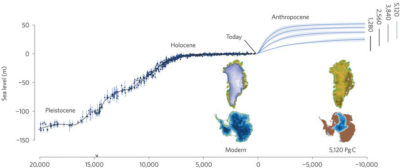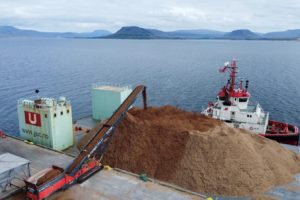A century or two from now, people may look back at our current era — with its record-breaking high temperatures year after year, rapid disappearance of Arctic sea ice, and gradually rising sea levels — as part of a much cooler and far more desirable past. The spate of extreme weather events in the past month — which have devastated America’s fourth-largest city, Houston; spawned a massive hurricane that tore through the Caribbean and Florida; and swamped large swaths of India and Bangladesh — may well be a prelude to more monster hurricanes, Biblical rain events, and coastal inundations brought about by extreme weather and vastly higher sea levels.
If getting the public, the media, and politicians to pay attention to what might happen to our planet in 2100 seems hard enough, it’s even more difficult to focus on how high — according to the latest research — sea levels may be only a couple of centuries in the future. Yet recent findings lend urgency to the need to contemplate what the world might look like 200 or 300 years from now if greenhouse gas emissions are not brought under control. “Urgent” may seem like a wildly inappropriate word when applied to such a long span of time, but the truth is that humanity’s continuing failure to bring our enormous carbon emissions under control will have planet-altering impacts that could continue not just for hundreds, but thousands, of years.
What’s coming down the road in just a few generations will be determined by the inescapable laws of chemistry and physics.
Why are we so concerned about the long-term threats global warming may pose to the stable climate that has nurtured human civilization over the past 10,000 years? Because by looking at previous eras of high, naturally occurring carbon emissions and cycles of glaciation and deglaciation, we can see what may well be in store for the earth should human-generated carbon emissions continue on a business-as-usual trajectory. And what’s coming down the road in but a few generations will be determined by the inescapable laws of chemistry and physics: Temperature increases lag behind C02 emissions, a crucial fraction of which can persist in the atmosphere for thousands of years. In turn, sea level increases lag well behind temperature increases. The end result is that the world’s oceans can be expected to continue rising for many thousands of years even after temperatures stabilize.
The sea level increases we’re accustomed to seeing today — rising at 1.2 inches per decade, considerably faster than 50 years ago — may well jump to several inches per decade in a century. But that will just be the beginning. Early stages of irreversible glacial collapse in Greenland and Antarctica indicate that considerably more rapid rise might be in store, although it’s impossible to say exactly when this might occur.
The geological record indicates that seas might have risen in the distant past at truly astounding rates — one foot per decade for centuries. Nothing remotely like that has been known in recorded human history. Yet having happened before, and given current greenhouse gas emissions trends, one can’t say that such epic rates, or higher, won’t happen again.
Long-term global mean sea-level change for the past 20,000 years (black line) and projections for the next 10,000 years, based on four possible carbon emission scenarios (1,280, 2,560, 3,840, and 5,120 gigatons). The illustration shows current and projected ice sheet extent on Greenland and Antarctica. Clark et al. 2017.
These possibilities ought to be part of the calculus in decisions about energy, coastal development, and economic policy. Being blind to what the future will look like centuries from now ignores science. Sea level increases will not just miraculously stop in 2100, often our current end-year for forecasting. Indeed, sea level rise may be fast accelerating around then, especially in high-carbon scenarios.
Research indicates that steadily accelerating sea level rise is possible and can become unstoppable for millennia because inertia in the climate system is enormous; a 2016 paper in Nature Climate Change, for example, indicated that sea levels could rise, far in the future, roughly 80 to 170 feet.
Given current trends, keeping to the stated Paris Agreement goal of warming by no more than about 3.6 degrees Fahrenheit (2 degrees Celsius) looks quite unlikely. This is to say nothing of what the world might look like in 2200, 2300, or after, if global temperatures rise 7 to 10 degrees F over today’s levels, a realistic projection given current emissions trends. Such a climate would be scarcely recognizable. Catastrophic storms and vastly higher sea levels aside, temperatures 7 to 10 degrees F hotter than today’s would wreak havoc with the oceans, agriculture, and, in the warmest parts of the world, go beyond human endurance.
A temperature increase of 7 degrees F is what separates today’s “ideal climate” from the dramatic conditions of the last Ice Age.
How big an impact would such a jump in temperatures have on the planet in the coming centuries? Consider this: A temperature increase of 7 to 12.6 degrees F (4 to 7 degrees C) is what separates today’s “ideal climate” from the dramatic conditions of the last Ice Age, which peaked about 26,000 years ago. At the height of the last Ice Age, ice sheets covered much of the northern hemisphere and piled up over some parts of North America to a depth of a mile or more.
Until a century or so ago, concentrations of carbon dioxide in the atmosphere had been steady at around 260 to 280 parts per million for thousands of years. By last spring we raced past 410 parts per million and CO2 concentrations continue to steadily increase. As carbon dioxide keeps accumulating in the atmosphere — 20 percent or more of the CO2 in the air today is expected to remain in the atmosphere until 3000 — we could conceivably reach concentrations of 900 to 1,000 parts per million CO2 in a century or two. That would rival C02 concentrations in the Eocene era, 50 million years ago, when global temperatures were as much as 29 degrees higher than pre-industrial temperatures — a time when there was scant ice on earth and temperatures differed little between the Equator and the poles.
What badly needs to be brought home to the public is the massive inertia in the climate system, which means changes in temperature and sea level will go on and on long past the year 2100.
For example, about 20,000 years ago, rising temperatures due to cyclical, non-human-caused swings in the climate were bringing earth out of the last Ice Age. Even after CO2 concentrations plateaued, global temperatures continued to increase, leveling off roughly at today’s levels about 11,000 years ago. Yet sea levels, which were several hundred feet lower than today at the peak of the last Ice Age because so much of the planet’s water was locked up in ice, continued to steadily climb for another 8,000 years, before roughly reaching their current state about 3,000 years ago.
Although we will unquestionably have a less hospitable climate in 2100 than today, that will be nothing compared to what might lie in store in 2200 and beyond. Yes, in 2100, sea levels might be three or more feet higher than today, which will be bad for low-lying nations like Bangladesh and U.S. states like Florida. But if greenhouse gas emissions continue at roughly today’s levels for another century, that may mean that sea levels 500 years from now would be nearly 50 feet higher as the Greenland and Antarctic ice sheets melt. That would mean losing large swaths of coastal areas worldwide. This is not alarmism; this is where the science takes us.
Given current and projected greenhouse gas emissions, we are looking at nothing less than creating a “forever legacy,” imposing monumental changes on the planet that can’t be readily unwound in a timeframe meaningful to our species.
Video credit: NASA
We are, at best, now thinking decades into the future, while pressing our foot hard on a CO2 accelerator that virtually guarantees climate chaos for millennia to come. That’s why the issue of considering the long-term costs we might be imposing on the planet is every bit as much a moral issue as a scientific one: Because of our collective failure to rapidly decarbonize the global economy and slash CO2 emissions, we are poised to leave future generations a grim legacy of climate upheaval.
So what is the way out? If there were a simple path, we’d already be following it. Opponents of strong action to curb greenhouse gas emissions say that this is alarmism, highly uncertain, and that to aggressively pursue a low-CO2 path would be onerous and cause widespread economic damage. Most countries are either, by default, choosing inaction or are moving far too slowly to make deep cuts in greenhouse gas emissions. But as renewable energy experts, we believe climate change presents opportunities: for cleaner air, new industries, job growth, and stronger economies.
Many solutions are well-known and are readily at hand. The first step might be enacting simple and transparent carbon taxes that begin to reflect true current and long-term costs of dumping CO2 into the atmosphere — costs that are in no way factored into the present-day global economy. It would be much smarter to tax “bads” like climate-changing greenhouse gases, than “goods” like work and productivity. That is what truly conservative, pro-growth, pro-jobs policies ought to look like.
The atmosphere and climate do not respond to hopes or aspirations.
Then there is carbon accounting across the public sector — including with the companies that want to do business with the government — and divestment of fossil fuel assets on the part of pension funds and financial institutions, as well as entities in the private, non-profit, and educational sectors. This is already happening in Northern Europe as renewables are simply growing much more attractive than dirty fossil fuels. And we need initial government support for clean-energy industries, as well as long-term funding for research and development on renewable energy, energy efficiency, and battery technologies.
We could also invest in technologies like “direct air capture” that might eventually employ millions of devices to extract CO2 from the atmosphere. But counting on “silver bullet” solutions to save us is not a sound strategy. These technologies use energy to operate themselves, and the scale of the challenge is immense, which is why we must immediately take concrete steps to drastically lower global emissions.
There is some reason for hope. Numerous European Union countries including Germany, and several U.S. states such as California, are making steady progress toward decarbonizing their economies. China is doing a lot more lately, though far, far more is needed. Sizeable segments of the private sector — including tech giants like Google, Apple, and Microsoft — are choosing clean energy solutions. But without large-scale coordinated action on many levels across government, academia, and the private sector, our efforts to drastically cut emissions will fall far short of what chemistry and physics demand. The atmosphere and climate do not respond to hopes or aspirations.
It’s not easy for humans to look far into the future; we are accustomed to thinking that every mistake can be undone and that the earth is unchanging. But the stakes with climate change are uniquely so high, and the damages to the planet and society so enormous, that scientists, the press, politicians, and the public need to peer a few centuries down the road and imagine what kind of world we will be leaving to our descendants.




